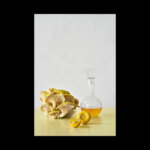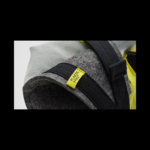
Atomic Connections: A Molecular Worldview
Written by Mark Paton Posted 2 July 2024
In Diego Velázquez’s ‘Las Meninas’, famous for its complexity and hidden messages, there is a small red pot that sits at the compositional epicentre of the canvas. This tiny jug, held by a young girl is a búcaro. In his forensic investigations, the art historian Byron Ellsworth Hamann, has identified the vessel’s distinct hue as a product of Guadalajara, Mexico. There, a carefully guarded recipe of native spices was fired into the clay, which had the attractive side effect of ensuring that any liquid it contained would carry a delicate perfume.
Besides adding fragrance, the búcaro had another surprising effect. In the 17th-century, girls and young women in Spanish aristocratic circles were known to nibble their way through the porous vases. The consequent chemical reactions were multiple. The visible effect was a dramatic lightening of the skin, but the unseen effects were as dramatic and debilitating: hallucination, depletion of red blood cells, muscle paralysis, liver damage.
Seen from 2023, this act of literally ‘consuming’ an artefact like a jug seems bizarre. Yet in many ways, we are all constantly running our own experiments of atomic interaction with the vast range of innovative products, materials, and chemicals that we surround ourselves with.

Velasquez’s inclusion of the búcaro in Las Meninas is but one example that Jesse Adler uses as a starting point to describe how her perception of our interaction with materials has developed. As a biomolecular scientist and interdisciplinary designer, with a background working in R&D as a materials innovation researcher at PANGAIA, Adler has a unique perspective that is now being expressed and built in to her company Pitri. Through her journey in generating colour from fungi (including mushrooms, lichens, yeasts, and moulds), she is merging her love for the natural world with planet-centred design, and gaining a different kind of worldview at an atomic level.
Her insights illustrate how our perspectives as designers can be expanded by sharing knowledge and experience with as wide a group of thinkers as possible:
When I met Adler, she summoned an image of constant atomic interaction with everything around us. Our skin, seen not as a barrier (the edge of ourselves), but instead a permeable membrane that is in a permanent state of extreme exchange.
At a cellular level, the atomic overhaul that our bodies go through is fairly mind boggling. 98% of the atoms in the body are replaced every year. Within the body this exchange takes place at different speeds. The atoms of the skin are replaced every four weeks, the atoms of the liver every six. The dynamism of this movement is dramatic: our bodies are in a constant state of flux.
In a subsequent conversation, she and I imagined a visual shift: from the neat silhouette of the human body with sharp defined edges – protected, limited – to one where that edge is blurred and moving. Imagine the solar corona visible during a total lunar eclipse.

This diffused and nuanced vision contrasts dramatically with my assumed relationship between myself and the objects, clothes, and fabrics that I surround myself with. In many ways, during my lifetime it feels like we’ve reached a zenith of production possibility – manufacturing mastery where anything is possible, any functionality achievable. What is becoming clear, is that this efficacy comes at a cost.
Burgeoning awareness of this is reflected in recent headlines: new studies on the effects of Ultra High Processed Foods, the Teflon Parkersburg scandal, the recent ban of per- and polyfluorinated (forever chemical) substances, a growing concern of toxic leaching in recycled plastics. The generational timeframes of the effects of these chemicals makes exact determination difficult, but the forming narrative is clear: our skin is anything but a barrier.
One key observation that builds from this is a common reality: a household that interrogates the ingredients of their food cupboard, yet fails to apply the same level of scrutiny to the cleaning supplies. This raises an interesting prospect for design in many fields in the notion that a more granular understanding of food – informed by more engaged exploration of our diets and farming practices, with a focus on complex interactions like the microbiome – could offer a pre-cursor to similar awareness when it comes to other facets of living: clothes, furniture, homes.

Some companies are wising up to the potential harm of these chemical exchanges. Swiss brand Mover espouses a tag line of Plastic Free Sportswear – a bold claim that requires a huge amount of technical development and innovation behind the scenes – often harnessing the performance of natural materials rather than relying on fabrics that are chemical enhanced.
Against this backdrop, it’s easy to fall into a general state of anxiety, but there is a flip side to the reading of the búcaro analogy. Healthwear brand Nufabrx is harnessing the exchange of atoms to answer a medical need: clothing that relieves pain symptoms directly at the source, with capsaicin-infused fabrics.
It is also possible that the outlook Adler offers presents other, more philosophical, opportunities in the creative sphere. To embrace a diffusion of boundaries. To design for humans in atomic flux. To open our minds to the impermanence of ourselves – a less self-centred worldview, with an understanding that we are not fixed and finite, rather flowing through – and with – everything around us.
For me, this one exchange of ideas was a timely reminder of the value of sharing thinking across disciplines – confirmation that we need to remain open to big concepts well beyond the specifications of typefaces and colours.

